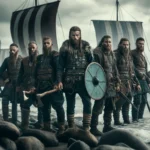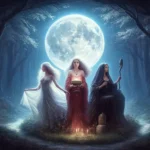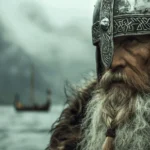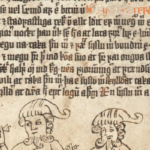Did the Vikings celebrate Halloween? The Norse warriors (and their children) certainly did not go trick or treating on the 31st of October, but this was still an important day in the Norse calendar.
The end of October marks the end of the harvest season and the beginning of winter, which means long, dark days, especially in northern countries such as Scandinavia. Many cultures mark this date with special rituals, including the Vikings. In the Norse world, it was called Alfablot, or the festival of the elves.
Who are the Elves?
The word “blot” is the name for important religious festivals in the Viking world, while the word “Alf” refers to the elves of Norse mythology.
When you read overviews of Norse mythology, you will often see the different races broken into discrete groups. There are the Aesir gods, the giants, the light elves, and the dark elves, also known as dwarves. But the reality is that the lines between these different groups were far from clear.
The Aesir gods and the giants intermarried regularly. Odin himself was half-giant since his mother was the giantess Bestla. He had Thor with the giantess Jord, making him more giant than god. As well as the Aesir gods, there were the Vanir gods, a parallel race of gods that included some of the most important Norse deities, including the goddess of love, Freyja, and the god of fertility, Freyr.
But the lines between the Vanir and the light elves were also blurred, with both being considered almost like nature spirits, and Freyr was the ruler of Alfheim, the land of the elves. And when we refer to the Alfar, it is not entirely clear whether the reference is to the Ljosalfar, the light elves that seem to have been like Tolkien’s elves, or the Dokkalfar, which were more like Tolkien’s dwarves and the master craftsmen of Norse mythology. The gods and elves were often referred to side by side as “Aesir ok Alfar”, which means Aesir and elves.
But more than this, the elves were also sometimes conflated with the honored dead and are described as living around burial mounds. Some important people were described as elves after they died. King Olaf of Geirstad became known as Olaf Geirstad-Alf when he was honored as an ancestor.
And the lines between the gods and the honored dead were also not clear. Fallen warriors were taken to live in Asgard, in the hall of Valhalla. Some of the entities considered among the gods, such as Bragi the Bard of Asgard, may have once been men.
What is the point of saying all this? Simply to emphasize that it is not always useful to try and draw clear lines between the different supernatural beings in Norse mythology or come up with clean definitions and typologies.

What Happened During Alfablot?
Alfablot seems to have been a private festival conducted inside the home, probably led by the leading woman of the household. The ritual probably involved honoring the dead ancestors of the specific household, and outsiders were not welcome.
This is revealed in the Skaldic poem Austrfararvisur by Sigvatr Thordarson. An Icelandic Christian, he describes himself and a small party traveling for diplomatic reasons. But for a few nights around the end of October, they struggle to find the hospitality that they are accustomed to receiving, with homestead after homestead refusing to open their doors.
The locals say that they cannot open their doors because their spaces have been sanctified for the period and that to open their doors to strangers would invite the wrath of Odin.
What kind of sacrifices may have been conducted to the elves at this time is indicated by an account in Kormaks Saga, which describes a ritual to invoke the help of the elves in healing a wound. They are told to go to the mound (presumably a burial mound) and make a blood sacrifice for the elves to feast, and they will be healed.

Day of the Dead
As well as being a day to honor the dead, it may also have signaled the start of a time of year when the dead were considered more likely to be “abroad”. While some dead found themselves in places such as Valhalla or Helheim, others were thought to occupy a world just behind a veil. During the night, this veil was sometimes passable.
In the Eddic poem Helgaknitha Hundingsbana II, the slain hero Helgi leaves Valhalla to visit his burial mound on one particular magical night. He has a physical body, which still bleeds from his battle wounds. His widow Sigrun encounters him there and he spends the night holding her in his arms before returning to Valhalla. Sigrun then returns to the burial mound every night in search of him. After a time, when he is no longer present, she dies of a broken heart.
While this story has an unhappy ending, it is still the story of a benevolent dead spirit pushing into the living world, but not all the dead were benevolent. Draugr or Aptrganga (after walkers) were malicious ghosts in Norse mythology, often born from dead men who were evil in life.
These dead had grotesque features including blue skin and eyes so terrible that they could freeze a man in fear. On top of this they have otherworldly strength and can terrorize nearby communities. They are known to have done things such as killing livestock, collapsing homes, and murdering shepherds and servants by breaking all of the bones in their bodies.
The Grettirs Saga, the antihero Grettir kills a Draugr early in his life and takes the short sword that the dead man was buried with as a prize. Years later, he faces another Draugr called Glam. He eventually decapitates him, but not before he places a terrible curse on the man that leaves him forever afraid of the dark.
The only way to kill these beings was to decapitate them, and then bury them with their heads below their pelvis. There are several Viking age burials that reflect this practice. Others show dead persons weighed down by rocks, presumably to prevent them from rising.
It is very likely that the rituals at the end of October were designed to honor the ancestors, and also appease them and prevent them from causing trouble over the coming dark months when they would have more freedom to invade the world of the living.

Viking Halloween
What do you think of Norse rituals and practices surrounding the 31st of October? Are any of them reflected in modern Halloween practices?








